Frequently Asked Questions
Answers to common questions
Concrete Filled Bagwork
Our 32N Concrete Bagwork product has been EPD (Environmental Product Declaration) Certified and is currently being assessed for BBA HAPAS Certification. In addition to this, our concrete bagwork is either compliant or exceeds the requirements of the Specification for Highways Works, Section 519. An full explanation as to where and why the product deviates from the SHW can be provided upon request, though bear in mind that in all important areas, our bagwork either matches or betters the requirements of the specification.
Each type of bagwork has the same appearance and dimensions, irrespective of the form of liner or concrete mix used. For schemes requiring a mix of the two types of bagwork, to make identification possible, each pallet of bagwork is colour coded with coloured shrink wrap. Underwater Bagwork is coloured blue and Above Water Bagwork is coloured Green. All pallets are also clearly labelled with each type of bagwork.
Our main product is our range of prefilled concrete bagwork. For those Contractors wishing to self-fill lined bagwork, we also offer a Contractors Pack, which includes sufficient bags and pins to complete a little over one cubic metre of finished bagwork. The self-fill contractors pack allows for wet mix placement as well as the Contractor being able to utilise a wider range of design mixes and additives.
We stock a standard size rebar pin that is suitable for our range of bagwork. This is a 300mm U shaped galvanised rebar pin formed from mild steel rebar, and they are available for immediate despatch. Other diameters, lengths, shapes and types of steel rebar can be sourced, however, lead times for cutting and bending, followed by galvanising if needed, can mean lead times of around three weeks for steelwork other than our standard sized pin.
Powdered anti-washout additives are generally an ineffective safeguard with dry mix placement in watercourses. Anti-washout additives (plasticisers) mixed within a dry mix concrete, only activate when the dry mix has been hydrated, creating a plasticised concrete that resists the escape of the cement fines from the mixed concrete. Almost all the risk in placing hand placed concrete in a watercourse comes from accidents or careless activity prior to being placed, and during this period the mix (including the anti-washout additive) is fully dry. A dropped or torn bag at this stage will still shed its powdered contents irrespective of an additive or not. Water to hydrate the concrete is only introduced once the bagwork has been placed in its intended position, although at this stage there is then no movement in the bagwork likely to result in leakage, as long as the use of steelwork follows our general guidelines for installation. The liner is there to provide a barrier between the contents inside the bag and the surrounding water, in effect, the liner replaces the need for an anti-washout additive.
The use of steelwork is prescribed in detail in the product specification literature. The seal between the bags and the pins, the draw of water into the bags caused by the dry material, combined with the way the steelwork is used, ensure the use of steelwork remains clean in water.
Due to the bulky and heavy nature of the prefilled bagwork, together with the need to ensure the product stays dry during transit, deliveries are made via hauliers using curtain sided haulage vehicles. The most cost effective and typical way to deliver is by 24T articulated lorry, although there is the option to deliver smaller quantities with smaller curtain sided vehicles.
Should you have any preference, please state at the time of enquiry so that suitable haulage options can be investigated and priced.
Delivery may be made with or without a tail lift and it is important that consideration be made to your off-loading capabilities at the place where they are to be unloaded. Where tail lifts are not possible, deliveries will need to be offloaded with a fork lift or telehandler. Where tail lifts are available, offloading can be completed with the vehicles pallet truck, onto a suitable, level hard standing area. It is therefore important that consideration be made to the offloading capabilities on site, and whether it is safe or practical to do so.
Specialist Hiab vehicle deliveries are also possible.
Of course, though the customer should ensure that the delivery address is easily locatable and accessible for a third party haulier. The customer should also ensure that the site delivery address is capable and safe for accepting haulage vehicles. Generally, we recommend all orders are delivered to a fixed, manned, permanent delivery address, such as a depot, which are easier to locate and more suited to haulage vehicles and offloading.
The buyer accepts responsibility, costs and all risks relating to losses or delays arising from deliveries requested to temporary site addresses and associated unloading problems.
Small quantities are typically possible within 2-3 working days, otherwise please allow up to 7 working days for delivery. We recommend contacting our sales department as early as possible to ensure we can meet your timescale for delivery, and to reserve stock.
Typical delivery times for Prefilled Bagwork:
England, Wales and Southern Scotland: 2-3 working days, or 3-5 working days on economy
Northern Scotland: 3-5 working days
Northern Ireland: 4-5 days
Eire: 4-5 days
Credit accounts and credit terms are available from Hoben International. Proforma payments may also be possible via BACS, cheque or credit card, with product despatched upon the receipt of a cleared payment.
For prices, please email us at sales@soluform.co.uk .
The introduction of water to harden the concrete is a major consideration and important it is made before ordering the type of bagwork. SoluForm’s Underwater Bagwork is suitable for placement below water, with the use of steelwork. It relies upon the surrounding river or seawater to harden the concrete. When bagwork is to be placed out of the water or away from a watercourse, consideration needs to be made to where the water will come from to harden the concrete. For schemes where bagwork is placed outside or away from any watercourse, our water soluble Above Water Bagwork may be suitable and can either be pre-soaked or wetted following placement. Please see the individual product datasheets for further information.
Our structural mix is a 32N limestone:cement concrete mix and is suitable for all forms of structural bagwork including underpinning, scour protection, culvert headwalls and river walls. The high strength creates a long lasting, durable concrete block with a longer design life and works particularly well with steel reinforcement.
The specification for this dry mix is comparable to an ST4 (20N) or Postmix concrete (8-12N). The Contractor should satisfy himself/herself as the suitability of the grade of concrete supplied, for the application in hand.
Prefilled bagwork is palletised and sold per pallet, with each prefilled bag now holding 20kg of dry mix concrete. Each pallet contains 50no. prefilled bags and this will be sufficient to complete approx. 0.69 cubic metres of finished bagwork. Bagwork is typically estimated in cubic metres, so to complete each cubic metre of concrete bagwork, assume that 1.5no. pallets of prefilled bagwork are required.
This depends upon where the bagwork is to be placed. Consideration should be given to where the water can be introduced to harden the concrete, and the associated environmental risk in doing so.
Underwater Bagwork is suitable for placement in the watercourse, where the surrounding water becomes absorbed by the dry mix, to harden the concrete. When using Underwater Bagwork, steelwork is used to pierce the bagwork, allowing water to absorb into the bag and hence hydrate the dry mix concrete. For placement in water, the biodegradable liner is needed to ensure the placement is clean and environmentally acceptable, last long enough to keep placement clean but then safely biodegrades.
Above Water Bagwork can be used in both above water and away from water applications where the lack of surrounding water needs to be overcome in order to hydrate the dry mix concrete. This is achieved by the use of water soluble liners which quickly dissolve on the addition of water, allowing the dry mix to be hydrated by pre-soaking or hosing down in situ. Please see the individual product datasheets for further information.
Yes, we have standard design drawings for 1m, 2m, and 3m walls for both River and Non-River Applications, completed by a Consulting Engineer. In addition to standard design drawings, we also have the accompanying Risk Assessments, Design Calculations and Design Check Statements for each design.
Please contact us and we would be happy to provide more information and any technical input you may require.
Soil Filled MSE Bagwork
A prefilled bag measures approximately 300mm x 540mm x 140mm in height. However, it is important to bear in mind that all soil filled bagwork will compress when loaded and ultimately soaked, in situ. Typically the length and width of the bags remains constant, but the height of each course will compress to typically 120mm (sometimes 105-115mm when the height of the wall exceeds 1.5m). A 1.5m high wall would typically settle into a 1.3m high wall, over the initial settling period, which would typically be several days/weeks, dependent upon rainfall, river levels etc.
The weight of each bag, as manufactured and supplied, is 20kg.
Volumetrically, each pallet contains up to 1.07m3 of newly placed MSE Bagwork. This is the nominal yield of the bagwork. Each pallet contains 50no. soil filled bags.
It is important however that you bear in mind the fact that the soil filled bagwork will compress over time and that the height of any wall formed will reduce over a short period of time as the bagwork is loaded and the soil becomes wet. As a guide, please work to the following reductions in height in your estimate of the quantity needed.
| Height comparisons between freshly laid bagwork and compacted, saturated bagwork | |||||||
| Initial height (m) | 1.00 | 1.50 | 1.73 | 2.00 | 2.30 | 2.50 | 2.88 |
| Eventual height (m) | 0.87 | 1.30 | 1.50 | 1.73 | 2.00 | 2.17 | 2.50 |
Based upon a known length of the wall, the initial height of the formed wall and a designed width to the wall, the volume of bagwork needed (and hence the number of pallets) can then be calculated. For quantity calculations we recommend you assume an effective yield per pallet to be 0.8m3, per pallet.
Remember, for below water applications we also recommend forming the base of the bagwork wall with our Underwater Concrete Bagwork. This forms a more stable and scour resistant base to any wall and the special lined nature of the Underwater Bagwork means that placement is very clean and environmentally safe. Concrete bagwork will not compress like soil filled bagwork, and is not affected like soil by the fact that it is constantly submerged.
Note that unlike concrete filled bagwork, the heights of any wall or feature formed with soil filled bagwork are approximate only and will change during the initial days and weeks following placement.
We supply the soil filled bagwork prefilled and with the necessary pins/shear keys to link all the soil filled bagwork together. When forming a wall or similar construction, remember to also consider:
- Fill material to be used for back filling
- A geogrid (if required by the designer)
- A geo-textile (if required by the designer)
- Seeding / planting options
- Concrete filled bagwork for any below water parts to the wall (if required)
No, we supply the bagwork materials only. Due to the simple nature of construction, the whole aim with soil filled bagwork is that it can be installed by anyone, so a specialist workforce is not required.
Yes, for every bag there is 1no. plastic shear key.
Currently, our MSE Bagwork is only available in prefilled form. These bags are prefilled with a high quality organic and sand rich BS 3882:2015 compliant topsoil, meaning the product arrives ready to place and you do not need to fill any bagwork on site.
Filled bagwork is supplied on a pallet, with fifty bags per pallet and each bag containing 20kg of quality topsoil. Empty bagwork is not currently available but will be available for 2022.
We currently do not provide pre-seeded prefilled bagwork. Details of our preferred Hydroseeding Contractor can be provided upon request.
We currently do not provide a formal design service for MSE bagwork projects and this is typically provided by Design Consultants. We can however provide informal design guidance, though formal designs, contract documentation and PI for any design solution should be sought from your appointed Design Consultant.
MSE design software is also available for free, online.







